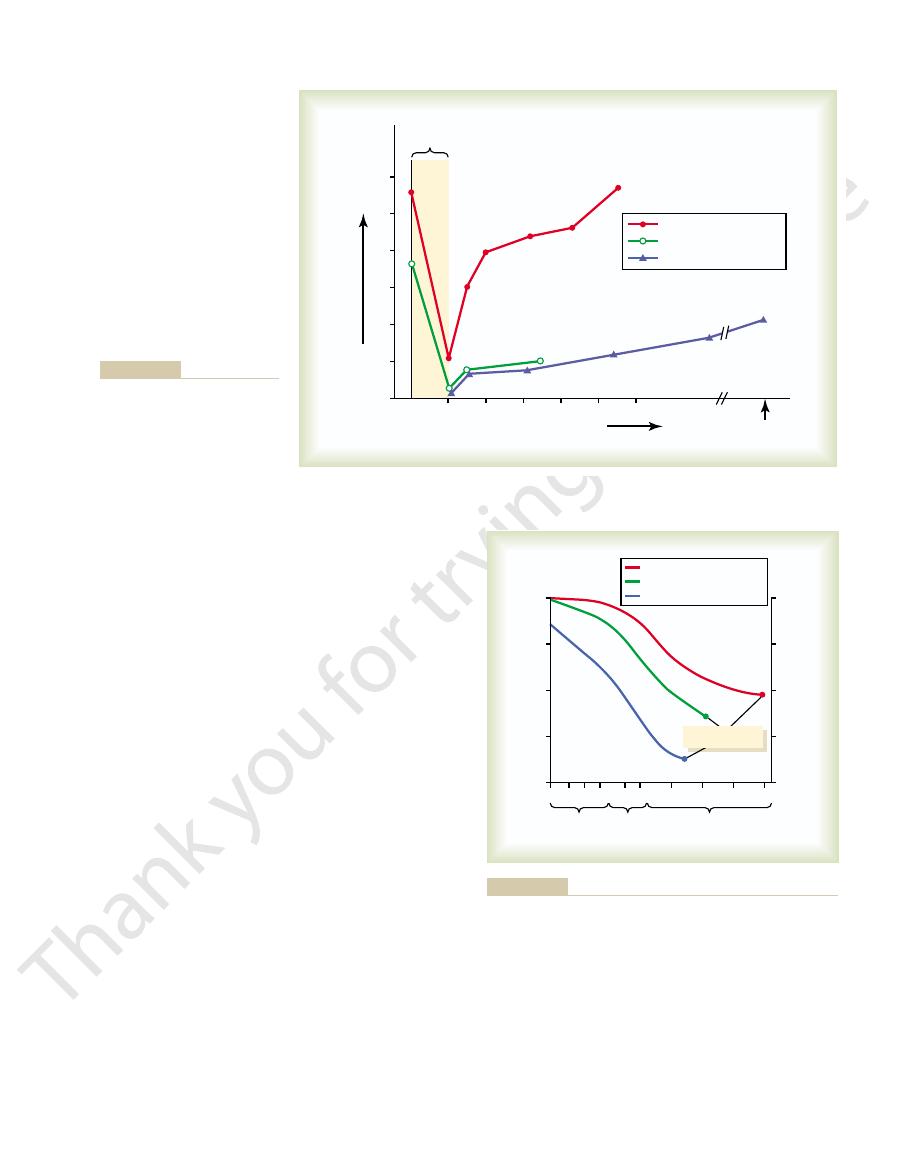
achieve in the performance of work, and how long they can continue their activity.
do for you—what strength they can give when it is needed, what power they can
The final common determinant of success in athletic events is what the muscles can
Strength, Power, and Endurance of Muscles
Muscles in Exercise
to the nonathletic male, who has about 15 per cent. This is a detriment to the highest
average nonathletic female has about 27 per cent body fat composition, in contrast
in the breasts, hips, and subcutaneous tissue. At least partly for this reason, the
terone. Estrogen is known to increase the deposition of fat in the female, especially
ence between female and male performance, although not nearly so much as testos-
The female sex hormone
40 per cent larger than those of a comparable female without the testosterone.
muscles. In fact, even a male who participates in very little sports activity but who
greatly increased deposition of protein everywhere in the body, but especially in the
Testosterone
and extra long-term energy.
the availability of extra fat seems to be an advantage for heat insulation, buoyancy,
than men—for instance, for the two-way swim across the English Channel, where
male performer. For other events, however, women have at times held records faster
by the relative running speeds for a marathon race. In a recent comparison, the top
The performance capabilities of the female versus the male athlete are illustrated
muscle, caused by endocrine differences that we discuss later.
. Therefore, most of the difference
When measured in terms of strength per square centimeter of cross-sectional area,
monary ventilation, and cardiac output, all of which are related mainly to the muscle
In general, most quantitative values for women—such as muscle strength, pul-
or absence of the male sex hormone testosterone.
differences caused by differences in body size, body composition, and the presence
athlete, almost identical basic physiologic principles apply, except for quantitative
been made. However, for those measurements that have been made in the female
are for the young male athlete, not because it is desirable to know only these values
son, the metabolism of the body during a marathon race may increase to 2000 per
the body metabolism increases to about 100 per cent above normal. By compari-
extremely high fever approaching the level of lethality,
give one simple example: In a person who has
several of the bodily mechanisms can be stressed. To
they might be lethal. Therefore, in the main, sports
were continued for even moderately prolonged periods,
exercise. In fact, if some of the extremes of exercise
There are few stresses to which the body is exposed that
C
H
A
P
T
E
R
8
4
1055
Sports Physiology
even nearly approach the extreme stresses of heavy
physiology is a discussion of the ultimate limits to which
cent above normal.
Female and Male Athletes
Most of the quantitative data that are given in this chapter
but because it is only in male athletes that relatively complete measurements have
mass—vary between two thirds and three quarters of the values recorded in men.
the female muscle can achieve almost exactly the same maximal force of contrac-
tion as that of the male-between 3 and 4 kg/cm
2
in total muscle performance lies in the extra percentage of the male body that is
female performer had a running speed that was 11 per cent less than that of the top
secreted by the male testes has a powerful anabolic effect in causing
nevertheless is well endowed with testosterone will have muscles that grow about
estrogen probably also accounts for some of the differ-
levels of athletic performance in those events in which performance depends on
speed or on ratio of total body muscle strength to body weight.

typical for the marathon race, their endurance (as meas-
high-carbohydrate diet. When athletes run at speeds
fat diet. Therefore, endurance is greatly enhanced by a
muscle before the period of exercise. A person on a
This, to a great extent, depends on the nutri-
endurance.
capability.
the velocity of a 30-minute race, despite the fourfold dif-
during less rapid but sustained activity. Thus, the veloc-
is for the next 30 minutes, because the
have a power of 1 kg-m/min. The maximal power
That is, a muscle
kilogram meters (kg-m) per minute.
each minute.
Power is therefore determined not only by the strength
work that the muscle performs in a unit period of time.
power
distance over which the force is applied. The
create the highest degree of muscle soreness.
in the muscle itself. In fact, forceful stretching of a max-
joints, and ligaments. It can also lead to internal tearing
This further compounds the problems of the tendons,
kilograms (1617 pounds) during holding contractions.
can be achieved by a shortening contraction. Therefore,
jump, this requires about 40 per cent more force than
stretch out the muscle, as occurs when landing after a
greater than the contractile strength. That is, if a muscle
The
tures about the joint, and torn ligaments.
happenings as displaced cartilages, compression frac-
ligaments spanning the joints, thus accounting for such
forces occur in tendons that span a joint, similar forces
insertion into the tibia below the knee. Also, when such
applied to the patellar tendon. Therefore, one can
of 525 kilograms (or 1155 pounds), with all this force
This would translate into a maximal contractile strength
cross-sectional area as great as 150 square centimeters.
To give an example of muscle strength, a world-class
of muscle cross-sectional area. Thus, a man who
size, with a
The strength of a muscle is determined mainly by its
1056
Unit XV
Sports Physiology
maximal contractile force between 3 and
4 kg/cm
2
is well supplied with testosterone or who has enlarged
his muscles through an exercise training program will
have correspondingly increased muscle strength.
weight lifter might have a quadriceps muscle with a
readily understand how it is possible for this tendon at
times to be ruptured or actually to be avulsed from its
are applied to the surfaces of the joint or sometimes to
holding strength of muscles is about 40 per cent
is already contracted and a force then attempts to
the force of 525 kilograms calculated above for the
patellar tendon during muscle contraction becomes 735
imally contracted muscle is one of the surest ways to
Mechanical work performed by a muscle is the
amount of force applied by the muscle multiplied by the
of
muscle contraction is different from muscle strength,
because power is a measure of the total amount of
of muscle contraction but also by its distance of
contraction and the number of times that it contracts
Muscle power is generally measured in
that can lift 1 kilogram weight to a height of 1 meter or
that can move some object laterally against a force of 1
kilogram for a distance of 1 meter in 1 minute is said to
achievable by all the muscles in the body of a highly
trained athlete with all the muscles working together is
approximately the following:
efficiency for
translation of muscle power output into athletic per-
formance is often much less during rapid activity than
ity of the 100-meter dash is only 1.75 times as great as
ference in short-term versus long-term muscle power
Another measure of muscle performance is
tive support for the muscle—more than anything else
on the amount of glycogen that has been stored in the
high-carbohydrate diet stores far more glycogen in
muscles than a person on either a mixed diet or a high-
ured by the time that they can sustain the race until
complete exhaustion) is approximately the following:
Next 1 minute
4000
First 8 to 10 seconds
7000
kg-m/min
This does not mean that one’s athletic performance is
fourth as great as during the initial power surge.
events, the power output of the muscles is only one
within 10 seconds, whereas for long-term endurance
extreme power surges for short periods of time, such as
Thus, it is clear that a person has the capability of
Next 30 minutes
1700
during a 100-meter dash that is completed entirely
four times as great during the initial power surge as it
Mixed diet
120
High-carbohydrate diet
240
Minutes
The amounts stored are approximately the following:
muscle before the race started explain these differences.
The corresponding amounts of glycogen stored in the
High-fat diet
85
Mixed diet
20
High-carbohydrate diet
40
g/kg Muscle
Then, when the second phosphate radical is removed,
are released to energize the muscle contractile process.
radical is removed, more than 7300 calories of energy
detail in Chapter 67). Therefore, when one phosphate
physical conditions in the body, which is discussed in
7300 calories of energy per mole of ATP under standard
energy phosphate bonds.
to the molecule, designated by the symbol ~, are
The bonds attaching the last two phosphate radicals
phate (ATP), which has the following basic formula:
The source of energy actually
Adenosine Triphosphate.
the aerobic system.
, (2)
ing the limits of physical activity. These systems are (1)
detail in Chapters 67 through 73. However, special
as in other parts of the body; these are discussed in
The same basic metabolic systems are present in muscle
High-fat diet
6
Muscle Metabolic Systems
in Exercise
quantitative measures of the activities of three meta-
bolic systems are exceedingly important in understand-
the phosphocreatine-creatine system
the glycogen-
lactic acid system, and (3)
used to cause muscle contraction is adenosine triphos-
Adenosine-PO
3
~ PO
3
~ PO
3
-
high-
Each of these bonds stores
conditions (and even slightly more than this under the

in terms of moles of ATP generation per
maximal rates of power
phosphagen system, the relative
AMP and ADP into ATP, as discussed in Chapter 67.
is, as shown to the left in Figure 84–1, glucose, fatty acids,
foodstuffs in the mitochondria to provide energy. That
The aerobic system is the oxidation of
reduced muscle power.
vided by the phosphagen system, although at somewhat
Under optimal conditions, the glycogen-lactic acid
used as a rapid source of energy. It is, however, only
contraction, this anaerobic glycolysis mechanism can be
mitochondria. Therefore, when large amounts of ATP
system is that it can form ATP molecules about 2.5
ATP are formed entirely without the consumption of
to lactic acid, but in doing so, considerable amounts of
Therefore, much of the muscle glycogen is transformed
, which diffuses out of
glucose metabolism to occur, most of the pyruvic acid
ATP molecules. However, when there is insufficient
as explained in Chapter 67. Ordinarily, the pyruvic
four ATP molecules for each original glucose molecule,
, and energy is released to form
pyruvic acid molecules
During glycolysis, each glucose molecule is split into two
(see Chapter 67).
, occurs without use of oxygen and, therefore,
used for energy. The initial stage of this process, called
The stored glycogen in
maximal short bursts of muscle power
Thus, the energy from the phosphagen system is used for
8 to 10 seconds, almost enough for the 100-meter run.
These together can provide maximal muscle power for
The combined amounts of cell ATP and cell phos-
in ATP.
able for muscle contraction, just as is the energy stored
tion of a second. Therefore, all the energy stored in the
phocreatine to ATP is that it occurs within a small frac-
to four times as much phosphocreatine as ATP.
bond of ATP. Furthermore, most muscle cells have two
son with 7300. Therefore, phosphocreatine can easily
the bond of ATP, 10,300 calories per mole in compari-
large amounts of energy. In fact, the high-energy phos-
shown to the left in Figure 84–1, and in doing so release
This can decompose to
phosphate bond, with the following formula:
provide a continuous supply of ATP in the muscle fibers.
energy to the muscles for contraction. The left-hand side
ATP first to ADP and then to AMP, with the release of
metabolic system, demonstrating the breakdown of
short athletic events. Figure 84–1 shows the overall
formed continuously, even during the performance of
few seconds at a time, it is essential that new ATP be
for one half of a 50-meter dash. Therefore, except for a
muscle power for only about 3 seconds, maybe enough
well-trained athlete, is sufficient to sustain maximal
The amount of ATP present in the muscles, even in a
this ADP into
(ADP), and removal of the second converts
of the first phosphate converts the ATP into
still another 7300 calories become available. Removal
Chapter 84
Sports Physiology
1057
adenosine
diphosphate
adenosine monophosphate (AMP).
of the figure shows the three metabolic systems that
Phosphocreatine-Creatine System
Phosphocreatine (also called creatine phosphate) is
another chemical compound that has a high-energy
Creatine
~ PO
3
-
creatine and phosphate ion, as
phate bond of phosphocreatine has more energy than
provide enough energy to reconstitute the high-energy
A special characteristic of energy transfer from phos-
muscle phosphocreatine is almost instantaneously avail-
phocreatine are called the phosphagen energy system.
.
Glycogen-Lactic Acid System
.
muscle can be split into glucose and the glucose then
glycolysis
is said to be anaerobic metabolism
acid then enters the mitochondria of the muscle cells
and reacts with oxygen to form still many more
oxygen for this second stage (the oxidative stage) of
then is converted into lactic acid
the muscle cells into the interstitial fluid and blood.
oxygen.
Another characteristic of the glycogen-lactic acid
times as rapidly as can the oxidative mechanism of the
are required for short to moderate periods of muscle
about one half as rapid as the phosphagen system.
system can provide 1.3 to 1.6 minutes of maximal
muscle activity in addition to the 8 to 10 seconds pro-
Aerobic System.
and amino acids from the foodstuffs—after some inter-
mediate processing—combine with oxygen to release
tremendous amounts of energy that are used to convert
In comparing this aerobic mechanism of energy
supply with the glycogen-lactic acid system and the
generation
minute are the following:
Amino acids
ATP
II. Glycogen
Lactic acid
I. Phosphocreatine
Creatine
+
PO
3
-
Energy
for muscle
contraction
ADP
AMP
+
Urea
III. Glucose
Fatty acids
CO
2
+
H
2
O
+
O
2
Important metabolic systems
Figure 84–1
that supply energy for muscle
contraction.
Glycogen–lactic acid system
2.5
Phosphagen system
4
Moles of ATP/min
Aerobic system
1

When comparing the same systems for endurance, the
cises heavily, and the rate of oxygen uptake increases
During the first 4 minutes of the figure, the person exer-
Figure 84–2 shows this principle of oxygen debt.
“repaid,” about 11.5 liters, is called the oxygen debt.
lactic acid system. All this extra oxygen that must be
and above the normal requirements. In addition, about
after the exercise is over, this stored oxygen must be
within a minute or so for aerobic metabolism. Then,
In heavy exercise, almost all this stored oxygen is used
selves, combined mainly with myoglobin, an oxygen-
blood, and (4) 0.3 liter stored in the muscle fibers them-
fluids, (3) 1 liter combined with the hemoglobin of the
the air of the lungs, (2) 0.25 liter dissolved in the body
stored oxygen consists of the following: (1) 0.5 liter in
lism even without breathing any new oxygen. This
The body normally contains about 2 liters
of the muscles.
and (2)
oxygen debt
two effects: (1) the so-called
aerobic energy capability is depleted. This results from
the early stages of heavy exercise, a portion of one’s
Recovery of the Aerobic System After Exercise.
of the muscles.
reconverted into glucose mainly in the liver, and the
all the body tissues. (2) The remaining lactic acid is
in two ways: (1) A small portion of it is converted back
oxidative metabolism, removal of lactic acid is achieved
When adequate amounts of energy are available from
lactic acid causes extreme fatigue.
lated in all the fluids of the body. This is especially
phocreatine, and the glycogen-lactic acid system.
to reconstitute all the other systems-the ATP, the phos-
1058
Unit XV
Sports Physiology
oxidative metabolism of the aerobic system can be used
Reconstitution of the lactic acid system means mainly
the removal of the excess lactic acid that has accumu-
important because
into pyruvic acid and then metabolized oxidatively by
glucose in turn is used to replenish the glycogen stores
Even during
deple-
tion of the glycogen stores
Oxygen Debt.
of stored oxygen that can be used for aerobic metabo-
binding chemical similar to hemoglobin.
replenished by breathing extra amounts of oxygen over
9 liters more oxygen must be consumed to provide for
reconstituting both the phosphagen system and the
relative values are the following:
Aerobic system
Unlimited time (as long as
Glycogen–lactic acid system
1.3 to 1.6 minutes
Phosphagen system
8 to 10 seconds
Time
phocreatine and ATP. And then energy from the
be used to reconstitute ATP, energy from the glycogen-
Recovery of the Muscle Metabolic Systems After Exercise.
in Table 84–1.
for each activity. Various approximations are presented
ering the vigor of a sports activity and its duration, one
What Types of Sports Use Which Energy Systems?
to 800-meter runs.
acid system, which is especially important for giving
longed athletic activity. In between is the glycogen-lactic
seconds, and the aerobic system is required for pro-
Thus, one can readily see that the phosphagen system
nutrients last)
is the one used by the muscle for power surges of a few
extra power during such intermediate races as the 200-
By consid-
can estimate closely which of the energy systems is used
In
the same way that the energy from phosphocreatine can
lactic acid system can be used to reconstitute both phos-
Table 84–1
Marathon run (26.2 miles, 42.2 km)
Tennis
Football dashes
Weight lifting
Jumping
Energy Systems Used in Various Sports
Phosphagen system, almost entirely
100-meter dash
Diving
Phosphagen and glycogen-lactic acid systems
200-meter dash
Basketball
Baseball home run
Ice hockey dashes
Glycogen-lactic acid system, mainly
400-meter dash
100-meter swim
Soccer
Glycogen-lactic acid and aerobic systems
800-meter dash
200-meter swim
1500-meter skating
Boxing
2000-meter rowing
1500-meter run
1-mile run
400-meter swim
Aerobic system
10,000-meter skating
Cross-country skiing
Jogging
0
4
8
12 16 20 24 28 32 36 40 44
0
5
4
3
2
1
Rate of oxygen uptake (L/min)
Exercise
Minutes
Alactacid oxygen debt = 3.5 liters
Lactic acid oxygen debt = 8 liters
This figure demonstrates the principle of
4 minutes and then for about 40 minutes after the exercise is over.
Rate of oxygen uptake by the lungs during maximal exercise for
Figure 84–2
oxygen debt.

Figure 84–4 shows the approximate relative usage of
mainly from fats.
the muscle now depends on energy from other sources,
further use for energizing muscle contraction. Instead,
longer than 4 to 5 hours, the glycogen stores of the
conditions, in those endurance athletic events that last
In fact, even under the best
amino acids.
Chapter 68), and they use to a much less extent proteins
stages of exercise, muscles use large amounts of fat for
muscles during exercise, especially during the early
recovery even after as long as 5 days. The messages of
fat, high-protein diet or on no food at all show very little
ery occurs in about 2 days. Conversely, people on a high-
food. Note that on a high-carbohydrate diet, full recov-
high-fat, high-protein diet; and third, in people with no
on a high-carbohydrate diet; second, in people on a
recovery process under three conditions: first, in people
lactic acid metabolic systems. Figure 84–3 shows this
often requires days, rather than the seconds, minutes, or
muscle glycogen depletion is not a simple matter. This
Recovery of Muscle Glycogen.
about 8 liters.
lactic acid oxygen debt
and amounts to about 3.5 liters. The latter portion
alactacid oxygen
lower level while the lactic acid is removed. The early
the oxygen debt, and then for another 40 minutes at a
the oxygen uptake still remains above normal, at first
more than 15-fold. Then, even after the exercise is over,
Chapter 84
Sports Physiology
1059
very high while the body is reconstituting the phospha-
gen system and repaying the stored oxygen portion of
portion of the oxygen debt is called the
debt
is called the
and amounts to
Recovery from exhaustive
hours required for recovery of the phosphagen and
this comparison are (1) that it is important for an athlete
to have a high-carbohydrate diet before a grueling ath-
letic event and (2) not to participate in exhaustive exer-
cise during the 48 hours preceding the event.
Nutrients Used During
Muscle Activity
In addition to the large usage of carbohydrates by the
energy in the form of fatty acids and acetoacetic acid (see
in the form of
muscle become almost totally depleted and are of little
carbohydrates and fat for energy during prolonged
exhaustive exercise under three dietary conditions:
0
10
20
30
40
High-carbohydrate diet
No food
Fat and protein diet
0
24
20
16
12
8
4
50
2 hours of
exercise
5 days
Muscle glycogen content (g/kg muscle)
Hours of recovery
Fox EL: Sports Physiology.
longed exercise. (Redrawn from
glycogen replenishment after pro-
Effect of diet on the rate of muscle
Figure 84–3
Philadelphia: Saunders College
Publishing, 1979.)
Seconds
Hours
20
4
1
2
3
0 10
40
High-carbohydrate diet
Mixed diet
High-fat diet
2
4
0
0
25
50
75
100
100
75
50
25
Per cent carbohydrate usage
Per cent fat usage
Minutes
Duration of exercise
Exhaustion
(Based partly on data in Fox EL: Sports Physiology. Philadelphia:
percentages of carbohydrate or fat used for energy by muscles.
Effect of duration of exercise as well as type of diet on relative
Figure 84–4
Saunders College Publishing, 1979.)

to the next. In addition, the enzymes of the aerobic
of diffusion of oxygen throughout the fiber by
muscle fiber; the extra myoglobin increases the rate
considerably more myoglobin, a hemoglobin-like
the fast-twitch fibers. In addition, they contain
energy. They have far more mitochondria than
endurance, especially for generation of aerobic
3. Slow-twitch fibers are mainly organized for
about twice as great as that of slow-twitch fibers.
fast-twitch fibers as in slow-twitch fibers, thus
2. The enzymes that promote rapid release of energy
diameter.
1. Fast-twitch fibers are about twice as large in
The basic differences between the fast-twitch and the
activity.
In contrast, the soleus muscle has a higher preponder-
ful and rapid contraction of the type used in jumping.
fast-twitch fibers, which gives it the capability of force-
For instance, the
slow-twitch muscle fibers.
twitch
being, all muscles have varying percentages of
Fast-Twitch and Slow-Twitch Muscle Fibers.
dation rate and efficiency of the oxidative metabolic
are increased, increasing especially the maximum oxi-
eride (fat). Because of all these changes, the capabilities
as 50 per cent increase in stored glycogen; and (5) as
including both ATP and phosphocreatine; (4) as much
enzymes; (3) as much as 60 to 80 per cent increase in
phy; (2) up to 120 per cent increase in mitochondrial
of myofibrils, proportionate to the degree of hypertro-
The changes that occur inside the hypertrophied
new fibers, thus increasing the number of fibers slightly.
but this probably is not entirely true, because a very few
muscle fibers rather than increased numbers of fibers,
perhaps an additional 30 to 60 per cent. Most of this
ing, however, the muscles can become hypertrophied
considerably larger muscles than in women. With train-
the level of testosterone secretion, which, in men, causes
The average size of a person’s
Muscle Hypertrophy.
their muscles atrophy tremendously. In these instances,
In old age, many people become so sedentary that
muscle hypertrophy.
equal percentage increase in muscle mass, which is
first 6 to 8 weeks but almost plateaus after that time.
resistive training program, demonstrating that the
The upper curve in Figure 84–5 shows the approxi-
producing chronic muscle fatigue.
mately optimal increase in muscle strength, without
Using this principle, experiments on muscle building
contractions are performed only a few times each day.
increase little in strength. At the other extreme, muscles
load, even if they are exercised for hours on end,
training is the following: Muscles that function under no
Importance of Maximal Resistance Training.
Effect of Athletic Training on
3 to 4 hours.
endurance event, one can expect fat to supply more than
intense muscle activity. Even so, for a long-term
available, they are the energy nutrients of choice for
Therefore, if muscle glycogen and blood glucose are
during prolonged events such as marathon races.
In addition, glucose solutions given to an athlete to
and then taken up by the muscles as an energy source.
as in the muscles, and this
glycogen. In fact, almost as much
rather than carbohydrates.
85 per cent of the energy is being derived from fats,
exercise, but at the time of exhaustion, as much as 60 to
high-carbohydrate diet, mixed diet, and high-fat diet.
1060
Unit XV
Sports Physiology
Note that most of the energy is derived from carbohy-
drates during the first few seconds or minutes of the
Not all the energy from carbohydrates comes from
the stored muscle
glycogen is stored in the liver
can be released into the blood in the form of glucose
drink during the course of an athletic event can provide
as much as 30 to 40 per cent of the energy required
50 per cent of the required energy after about the first
Muscles and Muscle Performance
One of the car-
dinal principles of muscle development during athletic
that contract at more than 50 per cent maximal force of
contraction will develop strength rapidly even if the
have shown that six nearly maximal muscle contractions
performed in three sets 3 days a week give approxi-
mate percentage increase in strength that can be
achieved in a previously untrained young person by this
muscle strength increases about 30 per cent during the
Along with this increase in strength is an approximately
called
muscle training often increases muscle strength more
than 100 per cent.
muscles is determined to a great extent by heredity plus
hypertrophy results from increased diameter of the
greatly enlarged muscle fibers are believed to split down
the middle along their entire length to form entirely
muscle fibers themselves include (1) increased numbers
the components of the phosphagen metabolic system,
much as 75 to 100 per cent increase in stored triglyc-
of both the anaerobic and the aerobic metabolic systems
system as much as 45 per cent.
In the human
fast-
and
gastrocnemius muscle has a higher preponderance of
ance of slow-twitch muscle fibers and therefore is used
to a greater extent for prolonged lower leg muscle
slow-twitch fibers are the following:
from the phosphagen and glycogen-lactic acid
energy systems are two to three times as active in
making the maximal power that can be achieved
for very short periods of time by fast-twitch fibers
protein that combines with oxygen within the
shuttling oxygen from one molecule of myoglobin
Weeks of training
0
2
4
6
8
10
0
30
25
20
15
10
5
Per cent increase in strength
Resistive training
No-load training
increase in muscle strength over a training period of 10 weeks.
Approximate effect of optimal resistive exercise training on
Figure 84–5

our respiratory systems during exercise? This can be
Limits of Pulmonary Ventilation.
and jumpers. For example, the following are recorded
born to be marathoners; others are born to be sprinters
is most suited to each person: some people appear to be
to be determined almost entirely by genetic inheritance,
type of athletic prowess over another. Instead, this seems
extent the athletic capabilities of different individuals.
more slow-twitch fibers; this could determine to some
more fast-twitch than slow-twitch fibers, and others have
Slow-Twitch Muscle Fibers.
Hereditary Differences Among Athletes for Fast-Twitch Versus
minutes to hours.
so. Conversely, slow-twitch fibers provide endurance,
In summary, fast-twitch fibers can deliver extreme
twitch fibers.
4. The number of capillaries is greater in the vicinity
slow-twitch fibers than in fast-twitch fibers.
Chapter 84
Sports Physiology
1061
metabolic system are considerably more active in
of slow-twitch fibers than in the vicinity of fast-
amounts of power for a few seconds to a minute or
delivering prolonged strength of contraction over many
Some people have considerably
Athletic training has not been shown to change the rel-
ative proportions of fast-twitch and slow-twitch fibers
however much an athlete might want to develop one
and this in turn helps determine which area of athletics
percentages of fast-twitch versus slow-twitch fiber in the
quadriceps muscles of different types of athletes:
How severely do we stress
answered by the following comparison for a normal
young man:
110
2.0
3.0
4.0
0
1.0
Moderate
exercise
Severe
exercise
0
120
100
80
60
40
20
Total ventilation (L/min)
O
2
consumption (L/min)
(Redrawn from Gray JS: Pulmonary Ventilation and Its Physiolog-
Effect of exercise on oxygen consumption and ventilatory rate.
Figure 84–6
ical Regulation. Springfield, IL: Charles C Thomas, 1950.)
Sprinters
63
37
Weight lifters
55
45
Average male
55
45
Swimmers
26
74
Marathoners
18
82
Fast-Twitch
Slow-Twitch
about 250 ml/min. However, under maximal conditions,
Oxygen Consumption and Pulmonary Ventilation in Exercise.
athletics.
concern in the performance of sprint types of athletics,
Although one’s respiratory ability is of relatively little
Respiration in Exercise
Jumpers
63
37
it is critical for maximal performance in endurance
Normal oxygen consumption for a young man at rest is
this can be increased to approximately the following
average levels:
Athletically trained average male
4000
Untrained average male
3600
ml/min
in the well-trained athlete.
be expected, that there is a linear relation. Both oxygen
levels of exercise. It is clear from this figure, as would
oxygen con-
Figure 84–6 shows the relation between
Male marathon runner
5100
sumption and total pulmonary ventilation at different
consumption and total pulmonary ventilation increase
about 20-fold between the resting state and maximal
intensity of exercise
Pulmonary ventilation at maximal exercise
100 to 110
L/min
genetically determined; that is, those people who have
this greater V
cent greater than that of an untrained person. Part of
earlier, the V
Max. Yet, as pointed out
effect on the increase in V
ing, whether two times or five times per week, had little
about 10 per cent. Furthermore, the frequency of train-
study, it is surprising that the V
suing the training program for 7 to 13 weeks. In this
athletic training on V
Max. Figure 84–7 shows the progressive effect of
The abbreviation for the rate
Effect of Training on V
limiting factor.
metabolism. We shall see shortly that the ability of the
The important point is that the respiratory system is
altitudes, (2) exercise under very hot conditions, and (3)
safety for athletes, giving them extra ventilation that can
during maximal exercise. This provides an element of
Thus, the maximal breathing capacity is about 50 per
Maximal breathing capacity
150 to 170
cent greater than the actual pulmonary ventilation
be called on in such conditions as (1) exercise at high
abnormalities in the respiratory system.
not normally the most limiting factor in the delivery of
oxygen to the muscles during maximal muscle aerobic
heart to pump blood to the muscles is usually a greater
.
O2
Max.
of oxygen usage under maximal aerobic metabolism is
V
.
O
2
.
O
2
Max recorded in a group of sub-
jects beginning at the level of no training and then pur-
.
O
2
Max increased only
.
O
2
.
O
2
Max of a marathoner is about 45 per
.
O
2
Max of the marathoner probably is
greater chest sizes in relation to body size and stronger
respiratory muscles select themselves to become

Muscle Blood Flow.
in Exercise
Cardiovascular System
respiratory distress. In fact, many such patients cannot
destroyed; then even the slightest exercise can cause
of many alveolar walls. In severe emphysema, as much
many of the terminal bronchioles, and (3) destruction
lowing occur: (1) chronic bronchitis, (2) obstruction of
of emphysema does not develop. In this disease, the fol-
There are few chronic smokers in whom some degree
Much more severe are the effects of chronic smoking.
strain during maximal exercise, and the level of per-
together, even a light smoker often feels respiratory
to the difficulty of breathing. Putting all these factors
from the respiratory passageways. As a result, much
linings. Third, nicotine paralyzes the cilia on the surfaces
bronchial tree, as well as some swelling of the epithelial
and out of the lungs. Second, the irritating effects of the
the lungs, which increases the resistance of airflow into
“wind.” This is true for many reasons. First, one effect
widely known that smoking can decrease an athlete’s
Effect of Smoking on Pulmonary Ventilation in Exercise.
from the contracting muscles and moving joints. All this
exercise. An additional part is believed to result from
during exercise, as discussed in Chapter 41. Part of this
Instead, respira-
respiration to be stimulated in exercise.
blood gases do not always have to become abnormal for
This demonstrates another important point:
heavy exercise.
Both of these values remain nearly normal, demon-
above normal. However, this normally is not the case.
oxygen by the muscles in exercise, one would expect
larly endurance training, does play an important role.
is not known, but it is very likely that training, particu-
procedures increases the diffusing capacity? The answer
of sports, or is it because something about the training
brane each minute is equal to the diffusing capacity. The
oxygen pressure in the blood is 90 mm Hg, the amount
pressure of oxygen in the alveoli is 91 mm Hg and the
That is, if the partial
pulmonary blood oxygen pressure.
ference between alveolar partial pressure of oxygen and
diffuse each minute for each millimeter of mercury dif-
milliliters of oxygen that will
diffuse from the pulmonary alveoli into the blood. This
oxygen diffusing
The
Figure 84–7.
of training increase the marathoner’s V
marathoners. However, it is also likely that many years
1062
Unit XV
Sports Physiology
.
O
2
Max by
values considerably greater than the 10 per cent that has
been recorded in short-term experiments such as that in
Oxygen Diffusing Capacity of Athletes.
capacity is a measure of the rate at which oxygen can
is expressed in terms of
of oxygen that diffuses through the respiratory mem-
following are measured values for different diffusing
capacities:
naturally greater diffusing capacities choose these types
Blood Gases During Exercise.
Because of the great usage of
the oxygen pressure of the arterial blood to decrease
markedly during strenuous athletics and the carbon
dioxide pressure of the venous blood to increase far
strating the extreme ability of the respiratory system to
provide adequate aeration of the blood even during
The
tion is stimulated mainly by neurogenic mechanisms
stimulation results from direct stimulation of the respi-
ratory center by the same nervous signals that are trans-
mitted from the brain to the muscles to cause the
sensory signals transmitted into the respiratory center
extra nervous stimulation of respiration is normally suf-
ficient to provide almost exactly the necessary increase
in pulmonary ventilation required to keep the blood
respiratory gases—the oxygen and the carbon dioxide—
very near to normal.
It is
of nicotine is constriction of the terminal bronchioles of
smoke itself cause increased fluid secretion into the
of the respiratory epithelial cells that normally beat con-
tinuously to remove excess fluids and foreign particles
debris accumulates in the passageways and adds further
formance may be reduced.
as four fifths of the respiratory membrane can be
even perform the simple feat of walking across the floor
of a single room without gasping for breath.
A key requirement of cardiovascular
function in exercise is to deliver the required oxygen
Weeks of training
2
4
6
8
10
12
14
Training frequency
0
= 5 days/wk
= 4 days/wk
= 2 days/wk
2.8
3.8
3.6
3.4
3.2
3.0
Vo
2
Max (L/min)
training. (Redrawn from Fox EL: Sports Physiology. Philadelphia:
Increase in V
Figure 84–7
.
O
2
Max over a period of 7 to 13 weeks of athletic
Saunders College Publishing, 1979.)
Swimmers during maximal exercise
71
Speed skaters during maximal exercise
64
Nonathlete during maximal exercise
48
Nonathlete at rest
23
ml/min
higher diffusing capacities. Is this because people with
maximal rates, thus providing a far greater surface area
cise, increased blood flow through the lungs causes
dormant in the resting state, whereas in maximal exer-
resting state and the state of maximal exercise. This
The most startling fact about these results is the sev-
Oarsman during maximal exercise
80
eralfold increase in diffusing capacity between the
results mainly from the fact that blood flow through
many of the pulmonary capillaries is sluggish or even
all the pulmonary capillaries to be perfused at their
through which oxygen can diffuse into the pulmonary
capillary blood.
It is also clear from these values that those athletes
who require greater amounts of oxygen per minute have

return and cardiac output. Typical cardiac outputs at
dilates the muscle blood vessels, thus increasing venous
oxygen consumption, and oxygen consumption in turn
functions, because the muscle work output increases
directly related to one another, as shown by the linear
during exercise. It is not surprising that all these are
work output, oxygen consumption, and cardiac output
Figure 84–9 shows the interrelations among
Work Output, Oxygen Consumption, and Cardiac Output During
often more than double the blood flow; this multiplies
Therefore, a 30 per cent increase in blood pressure can
flow that can occur in a well-trained athlete.
muscles during exercise increases markedly. The fol-
the continuous contraction. (2) The blood flow to
lar blood vessels; therefore, strong
this study: (1) The actual contractile process itself
muscle contraction. Two points can be made from
tractions. Note not only the great increase in flow—
during exercise. Figure 84–8 shows a recording of
purpose, the muscle blood flow increases drastically
and other nutrients to the exercising muscles. For this
Chapter 84
Sports Physiology
1063
muscle blood flow in the calf of a person for a period of
6 minutes during moderately strong intermittent con-
about 13-fold—but also the flow decrease during each
temporarily decreases muscle blood flow because the
contracting skeletal muscle compresses the intramuscu-
tonic muscle con-
tractions can cause rapid muscle fatigue because of lack
of delivery of enough oxygen and other nutrients during
lowing comparison shows the maximal increase in blood
the great increase in flow already caused by the meta-
bolic vasodilation at least another twofold.
Exercise.
several levels of exercise are the following:
0
10
18
16
Calf
flow
Rhythmic exercise
20
40
Blood flow (100 mL/min)
Minutes
rhythmic exercise. J Physiol 109:402, 1949.)
Barcroft H, Dornhors AC: Blood flow through human calf during
during contraction than between contractions. (Redrawn from
ing strong rhythmical contraction. The blood flow was much less
Effects of muscle exercise on blood flow in the calf of a leg dur-
Figure 84–8
Resting blood flow
3.6
ml/100 g Muscle/min
oles and further reduces the vascular resistance.
cise, usually about a 30 per cent increase. The increase
21. The remaining increase results from multiple factors,
increased muscle metabolism, as explained in Chapter
about 25-fold during the most strenuous exercise.
Thus, muscle blood flow can increase a maximum of
Blood flow during maximal exercise
90
Almost one half this increase in flow results from intra-
muscular vasodilation caused by the direct effects of
the most important of which is probably the moderate
increase in arterial blood pressure that occurs in exer-
in pressure not only forces more blood through the
blood vessels but also stretches the walls of the arteri-
Maximal cardiac output during exercise in
30
Maximal cardiac output during exercise in young
23
Cardiac output in young man at rest
5.5
L/min
untrained man
185 beats/min, an increase of 270 per cent. Therefore,
50 per cent, whereas the heart rate increases from 50 to
increases from 105 to 162 milliliters, an increase of about
30 L/min in the marathon runner. The
Figure 84–10 shows the approximate changes in
Role of Stroke Volume and Heart Rate in Increasing the Cardiac
athlete than in the untrained person, but there is a cor-
Thus, the heart-pumping effectiveness of each heart-
in the untrained person and the marathoner.
rate. Table 84–2 compares stroke volume and heart rate
normal person. However, this normal cardiac output is
erably larger than that of the normal person, resting
letic training.
in the endurance types, not in the sprint types, of ath-
ing but the heart does also. However, heart enlargement
increases 40 per cent or more. Therefore, not only do
enlargement of the chambers, the heart mass also
marathoners enlarge about 40 per cent; along with this
greater than those achieved by untrained persons. This
From the foregoing data, it is clear that marathoners can
Effect of Training on Heart Hypertrophy and on Cardiac Output.
outputs as great as 35 to 40 L/min, seven to eight times
cardiac output a little over fourfold, and the well-
Thus, the normal untrained person can increase
average male marathoner
trained athlete can increase output about sixfold.
(Individual marathoners have been clocked at cardiac
normal resting output.)
achieve maximal cardiac outputs about 40 per cent
results mainly from the fact that the heart chambers of
the skeletal muscles hypertrophy during athletic train-
and increased pumping capacity occur almost entirely
Even though the heart of the marathoner is consid-
cardiac output is almost exactly the same as that in the
achieved by a large stroke volume at a reduced heart
beat is 40 to 50 per cent greater in the highly trained
responding decrease in heart rate at rest.
Output.
stroke volume and heart rate as the cardiac output
increases from its resting level of about 5.5 L/min to
stroke volume
the heart rate increase accounts by far for a greater

these reasons, as well as reduced skeletal muscle mass,
even more decrease in maximal breathing capacity. For
cent decrease between age 18 and age 80. Also, there is
The maximal cardiac output of older people also
much less to walk across the floor.
total body muscle power. Therefore, a person with con-
athletics, one can readily understand that any type of
important physiologic benefit of the marathoner’s train-
exercising muscles. Therefore, the 40 per cent greater
bility of his or her heart, because this is the most limit-
For this reason, it is frequently stated that the level
diovascular system can transport oxygen to the tissues.
respiratory system, because oxygen utilization by the
is normally much more limiting on V
fore, one can readily see that the cardiovascular system
per cent of maximum for pulmonary ventilation. There-
the person can achieve. This is in contrast to about 65
heart rate, one finds that the
maximal levels. Because the cardiac output is equal
maximal exercise, both the heart rate and the stroke
must occur by increasing the heart rate.
to its maximum. Any further increase in cardiac output
The stroke volume normally reaches its maximum by
the increase in stroke volume during strenuous exercise.
1064
Unit XV
Sports Physiology
proportion of the increase in cardiac output than does
the time the cardiac output has increased only halfway
Relation of Cardiovascular Performance to V
.
O2
Max.
During
volume are increased to about 95 per cent of their
to stroke volume times
cardiac output is about 90 per cent of the maximum that
.
O
2
Max than is the
body can never be more than the rate at which the car-
of athletic performance that can be achieved by the
marathoner mainly depends on the performance capa-
ing link in the delivery of adequate oxygen to the
cardiac output that the marathoner can achieve over the
average untrained male is probably the single most
ing program.
Effect of Heart Disease and Old Age on Athletic Performance.
Because of the critical limitation that the cardiovascu-
lar system places on maximal performance in endurance
heart disease that reduces maximal cardiac output will
cause an almost corresponding decrease in achievable
gestive heart failure frequently has difficulty achieving
even the muscle power required to climb out of bed,
decreases considerably—there is as much as a 50 per
Work output during exercise (kg-meters/min)
0
200
400
600
800
1000 1200 1400
Dexter 1951
Douglas 1922
Christensen 1931
Donald 1956
1600
0
0
4
3
2
1
0
15
10
5
35
30
25
20
15
10
5
Cardiac output (L/min)
Oxygen consumption (L/min)
Cardiac index (L/min/m
2
)
Oxy
gen consu
mption
Cardiac output and cardiac index
Physiology: Cardiac Output and
CE, Coleman TB: Circulatory
(Redrawn from Guyton AC, Jones
during different levels of exercise.
Relation between cardiac output
Figure 84–9
and work output (solid line) and
between oxygen consumption
and work output (dashed line)
Its Regulation. Philadelphia: WB
Saunders Co, 1973.)
Table 84–2
Comparison of Cardiac Function Between Marathoner
Nonathlete
110
195
Marathoner
105
50
Nonathlete
75
75
Stroke Volume (ml)
Heart Rate (beats/min)
and Nonathlete
Resting
Maximum
Marathoner
162
185
110
0
10
15
20
25
30
105
50
Stroke volume
Heart rate
190
170
150
130
90
70
165
150
135
120
Heart rate (beats/min)
Stroke volume (ml/beat)
Cardiac output (L/min)
of cardiac output in a marathon athlete.
Approximate stroke volume output and heart rate at different levels
Figure 84–10

which promote heart attacks and strokes.
teins, and increased low-density lipoproteins, all of
hypertension, decreased high-density blood lipopro-
However, anabolic steroids also greatly increase the risk
some conditions, especially in women and even in men.
Second, use of
ments by others have failed to confirm any advantage,
those found in one to three cups of coffee. Yet experi-
performance. In one experiment on a marathon runner,
First,
effects of drugs in athletics.
Without belaboring this issue, let us list some of the
in the form of fruit juices.
tioned amounts of potassium along with sodium, usually
a consequence of these findings, some of the supple-
loss of potassium in the urine as well as in the sweat. As
terone during heat acclimatization, which increases the
trolyte problem—the loss of potassium. Potassium loss
during athletic events.
surface of the skin. Once the athlete is acclimatized,
effect on the sweat glands, increasing reabsorption of
the adrenal cortex. The aldosterone in turn has a direct
before acclimatization. This sweat gland acclimatization
become acclimatized, so that the amount of salt lost in
athletic feats on the first day, the sweat glands also
thermore, if an athlete becomes acclimatized to the heat
salt tablets has often done as much harm as good. Fur-
exercise on hot and humid days. However, overuse of
tains a large amount of sodium chloride, for which
nausea, and other effects. Therefore, it is essential to
weight can often be serious, leading to muscle cramps,
formance, and a 5 to 10 per cent rapid decrease in
only 3 per cent can significantly diminish a person’s per-
sweat. Loss of enough sweat to decrease body weight
tions. Essentially all this weight loss results from loss of
in Exercise
a mush of crushed ice if available.
as any other procedure, although some physicians
sponge the body, and blow air over the body with a fan.
way to do this is to remove all clothing, maintain a spray
temperature as rapidly as possible. The most practical
The treatment of heatstroke is to reduce the body
doubles the rates of all intracellular chemical reactions,
Chapter 73). A second reason is that in heatstroke, the
reasons for this is that at these high temperatures, the
ture does not easily decrease by itself. One of the
though the person has stopped exercising, the tempera-
to treat it immediately can lead to death. In fact, even
, and failure
This whole complex is called
and unconsciousness.
profuse sweating, confusion, staggering gait, collapse,
weakness, exhaustion, headache, dizziness, nausea,
tiple symptoms begin to appear, including extreme
cells, especially the brain cells. When this happens, mul-
rise to 106° to 108°F (41° to 42°C). At this level, the ele-
tions or excess clothing, the body temperature can easily
103°F (37° to 40°C). With very hot and humid condi-
ture often rises from its normal level of 98.6° to 102° or
normal environmental conditions, the body tempera-
During endurance athletics, even under
easily develop in the athlete.
ing mechanism cannot eliminate the heat, an intolera-
the body, on a very hot and humid day so that the sweat-
athletic events. Next, with a vast rate of heat flow into
sumption (as discussed in Chapter 72), one quickly real-
Now, recognizing that the oxygen consumption by the
and (3) other, similar effects—all of which convert
friction of the blood flowing through the blood vessels,
ment of the muscles and joints, (2) overcoming the
chemical reactions. Second, almost all the energy that
per cent; the remainder of the nutrient energy is con-
work, even under the best of conditions, is only 20 to 25
efficiency for conversion of nutrient energy into muscle
traction for the following reasons: First, the maximal
This applies even to the energy that causes muscle con-
Almost all the energy released by the body’s metabo-
Body Heat in Exercise
reduced in old age.
Chapter 84
Sports Physiology
1065
the maximal achievable muscle power is greatly
lism of nutrients is eventually converted into body heat.
verted into heat during the course of the intracellular
does go into creating muscle work still becomes body
heat because all but a small portion of this energy is
used for (1) overcoming viscous resistance to the move-
the muscle contractile energy into heat.
body can increase as much as 20-fold in the well-trained
athlete and that the amount of heat liberated in the
body is almost exactly proportional to the oxygen con-
izes that tremendous amounts of heat are injected into
the internal body tissues when performing endurance
ble and even lethal condition called heatstroke can
Heatstroke.
vated temperature itself becomes destructive to tissue
heatstroke
temperature-regulating mechanism itself often fails (see
very high body temperature itself approximately
thus liberating still more heat.
of cool water on all surfaces of the body or continually
Experiments have shown that this treatment can reduce
the temperature either as rapidly or almost as rapidly
prefer total immersion of the body in water containing
Body Fluids and Salt
As much as a 5- to 10-pound weight loss has been
recorded in athletes in a period of 1 hour during
endurance athletic events under hot and humid condi-
replace fluid as it is lost.
Replacement of Sodium Chloride and Potassium.
Sweat con-
reason it has long been stated that all athletes should
take salt (sodium chloride) tablets when performing
by progressive increase in athletic exposure over a
period of 1 to 2 weeks rather than performing maximal
the sweat becomes only a small fraction of that lost
results mainly from increased aldosterone secretion by
sodium chloride from the sweat before the sweat itself
issues forth from the sweat gland tubules onto the
only rarely do salt supplements need to be considered
Experience by military units exposed to heavy exer-
cise in the desert has demonstrated still another elec-
results partly from the increased secretion of aldos-
mental fluids for athletics contain properly propor-
Drugs and Athletes
caffeine is believed by some to increase athletic
running time for the marathon was reduced by 7 per
cent by judicious use of caffeine in amounts similar to
thus leaving this issue in doubt.
male sex hormones (androgens) or
other anabolic steroids to increase muscle strength
undoubtedly can increase athletic performance under
of cardiovascular damage because they often cause

exercise: is there a controversy? J Appl Physiol 93:1185,
cylglycerol utilization in human skeletal muscle during
Watt MJ, Heigenhauser GJ, Spriet LL: Intramuscular tria-
Physiol 86:1101, 1999.
mining oxygen uptake at the onset of exercise. J Appl
Tschakovsky ME, Hughson RL: Interaction of factors deter-
95:2152, 2003.
aging on physiological functional capacity. J Appl Physiol
Masters athletes: insight into the effects of primary human
Tanaka H, Seals DR: Dynamic exercise performance in
Physiol Scand 179:39, 2003.
regulation in skeletal muscle fatigue. Acta
Steele DS, Duke AM: Metabolic factors contributing to
178:413, 2003.
vidual skeletal muscle fibre types. Acta Physiol Scand
Spangenburg EE, Booth FW: Molecular regulation of indi-
Physiol 283:R2, 2002.
Schnermann J: Exercise. Am J Physiol Regul Integr Comp
Physiol 66:799, 2004.
Control of the size of the human muscle mass. Annu Rev
Rennie MJ, Wackerhage H, Spangenburg EE, Booth FW:
hypoxia and hyperoxia. J Exp Biol 204:3225, 2001.
Noakes TD, Peltonen JE, Rusko HK: Evidence that a central
Biochem Physiol A Mol Integr Physiol 136:171, 2003.
class? Not simply a physiological conundrum. Comp
Myburgh KH: What makes an endurance athlete world-
Exerc 34:364, 2002.
resistance training for healthy adults. Med Sci Sports
of Sports Medicine position stand. Progression models in
Kraemer WJ, Adams K, Cafarelli E, et al: American College
performance. Sports Med 34:51, 2004.
eride and glycogen in endurance exercise: implications for
Johnson NA, Stannard SR, Thompson MW: Muscle triglyc-
ance. News Physiol Sci 17:122, 2002.
Hochachka PW, Beatty CL, Burelle Y, et al: The lactate
WB Saunders Co, 1973.
Cardiac Output and Its Regulation, 2nd ed. Philadelphia:
Guyton AC, Jones CE, Coleman TB: Circulatory Physiology:
hypertrophy and atropy. Nat Cell Biol 5:87, 2003.
Glass JD: Signalling pathways that mediate skeletal muscle
muscle fatigue. Physiol Rev 81:1725, 2001.
Gandevia SC: Spinal and supraspinal factors in human
steroids. Am J Sports Med 32:534, 2004.
Evans NA: Current concepts in anabolic-androgenic
fusion during exercise. Acta Physiol Scand 162:411, 1998.
Delp MD, Laughlin MH: Regulation of skeletal muscle per-
Comp Physiol 285:R720, 2003.
pumps in skeletal muscle. Am J Physiol Regul Integr
Clausen T: Effects of age and exercise training on NA
96:3, 2004.
understanding of modern chronic diseases. J Appl Physiol
genotypes: connecting the dots toward an evolutionary
Chakravarthy MV, Booth FW: Eating, exercise, and “thrifty”
543:399, 2002.
human genome through physical activity. J Physiol
and gene expression: physiological regulation of the
Booth FW, Chakravarthy MV, Spangenburg EE: Exercise
Am J Clin Nutr 79:913S, 2004.
physical activity recommendations. How much is enough?
Blair SN, LaMonte MJ, Nichaman MZ: The evolution of
letically fit old person than in the nonfit person.
require all available respiratory reserve. In addition, the
may have twice as much reserve. This is especially
However, an athletically fit old person
he or she does become sick. For instance, an 80-year-old
cally fit person has more bodily reserves to call on when
Second, and perhaps equally important, the athleti-
reduce the number of heart attacks and brain strokes.
pointed out earlier, these changes all work together to
along with increased high-density lipoprotein. As
cardiovascular disease. This results from (1) mainte-
First, body fitness and weight control greatly reduce
ing are the two most evident reasons.
But why does body fitness prolong life? The follow-
times less in the most fit people than in the least fit.
50 and 70, studies have shown mortality to be three
benefit of prolonged life. Especially between the ages of
of exercise and weight control, have the additional
tain appropriate body fitness, using judicious regimens
Body Fitness Prolongs Life
within seconds.
heart, leading to ventricular fibrillation, which is lethal
system during exercise. One of the possible causes of
except as a psychic stimulant. Some athletes have been
deterioration of performance. Furthermore, experi-
been reputed to increase one’s athletic performance. It
, have
Other drugs, such as
bass voice, ruddy skin, and cessation of menses.
adapted to the male sex hormone—hair on the face, a
months and perhaps indefinitely. In a woman, even
secretion of the person’s own natural testosterone, with
also leads to decreased testicular function, including
In men, any type of male sex hormone preparation
1066
Unit XV
Sports Physiology
both decreased formation of sperm and decreased
residual effects sometimes lasting at least for many
more dire effects can occur because she is not normally
amphetamines and cocaine
is equally true that overuse of these drugs can lead to
ments have failed to prove the value of these drugs
known to die during athletic events because of interac-
tion between such drugs and the norepinephrine and
epinephrine released by the sympathetic nervous
death under these conditions is overexcitability of the
Multiple studies have now shown that people who main-
nance of moderately lower blood pressure and (2)
reduced blood cholesterol and low-density lipoprotein
nonfit person may have a respiratory system that limits
oxygen delivery to the tissues to no more than 1 L/min;
this means a respiratory reserve of no more than three-
fold to fourfold.
important in preserving life when the older person
develops conditions such as pneumonia that can rapidly
ability to increase cardiac output in times of need (the
“cardiac reserve”) is often 50 per cent greater in the ath-
References
+
K
+
paradox in human high-altitude physiological perform-
governor regulates exercise performance during acute
altered Ca
2
+
2002.
